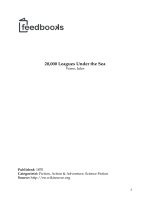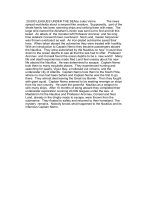Twenty thousand leagues under the sea, by jules verne
Bạn đang xem bản rút gọn của tài liệu. Xem và tải ngay bản đầy đủ của tài liệu tại đây (1.36 MB, 340 trang )
The Project Gutenberg eBook of Twenty
Thousand Leagues Under the Sea, by Jules
Verne
Copyright laws are changing all over the world. Be sure to check the
copyright laws for your country before downloading or redistributing
this or any other Project Gutenberg eBook.
This header should be the first thing seen when viewing this Project
Gutenberg file. Please do not remove it. Do not change or edit the
header without written permission.
Please read the "legal small print," and other information about the
eBook and Project Gutenberg at the bottom of this file. Included is
important information about your specific rights and restrictions in
how the file may be used. You can also find out about how to make a
donation to Project Gutenberg, and how to get involved.
**Welcome To The World of Free Plain Vanilla Electronic Texts**
**eBooks Readable By Both Humans and By Computers, Since 1971**
*****These eBooks Were Prepared By Thousands of Volunteers!*****
Title: Twenty Thousand Leagues Under the Sea
Author: Jules Verne
Release Date: January, 2002 [EBook #2488]
[This html file was first posted on June 10, 2003]
Edition: 10
Language: English
*** START OF THE PROJECT GUTENBERG EBOOK, TWENTY THOUSAND LEAGUES UNDER THE SEA ***
HTML version prepared by William Fishburne
Twenty Thousand Leagues Under the Seas
An Underwater Tour of the World
JULES VERNE
Translated from the Original French by F. P. Walter
Text Prepared by: F. P. Walter, 1433 Cedar Post, No. 31,
Houston, Texas 77055. (713) 827–1345
A complete, unabridged translation of Vingt milles lieues sous les mers by Jules Verne, based on the
original French texts published in Paris by J. Hetzel et Cie. over the period 1869–71.
VERNE'S TITLE
The French title of this novel is Vingt mille lieues sous les mers. This is accurately translated as
Twenty Thousand Leagues Under the SEAS—rather than the SEA, as with many English editions.
Verne's novel features a tour of the major oceans, and the term Leagues in its title is used as a
measure not of depth but distance. Ed.
Contents
Introduction
Units of Measure
FIRST PART
1.
2.
3.
4.
5.
6.
7.
8.
9.
10.
11.
12.
13.
14.
15.
16.
17.
18.
19.
20.
21.
22.
23.
24.
A Runaway Reef
The Pros and Cons
As Master Wishes
Ned Land
At Random!
At Full Steam
A Whale of Unknown Species
"Mobilis in Mobili"
The Tantrums of Ned Land
The Man of the Waters
The Nautilus
Everything through Electricity
Some Figures
The Black Current
An Invitation in Writing
Strolling the Plains
An Underwater Forest
Four Thousand Leagues Under the Pacific
Vanikoro
The Torres Strait
Some Days Ashore
The Lightning Bolts of Captain Nemo
"Aegri Somnia"
The Coral Realm
SECOND PART
1.
2.
3.
4.
5.
6.
7.
8.
9.
10.
11.
12.
13.
14.
15.
16.
17.
18.
19.
20.
21.
22.
23.
The Indian Ocean
A New Proposition from Captain Nemo
A Pearl Worth Ten Million
The Red Sea
Arabian Tunnel
The Greek Islands
The Mediterranean in Forty–Eight Hours
The Bay of Vigo
A Lost Continent
The Underwater Coalfields
The Sargasso Sea
Sperm Whales and Baleen Whales
The Ice Bank
The South Pole
Accident or Incident?
Shortage of Air
From Cape Horn to the Amazon
The Devilfish
The Gulf Stream
In Latitude 47° 24' and Longitude 17° 28'
A Mass Execution
The Last Words of Captain Nemo
Conclusion
Introduction
"The deepest parts of the ocean are totally unknown to us," admits Professor Aronnax early in this
novel. "What goes on in those distant depths? What creatures inhabit, or could inhabit, those regions
twelve or fifteen miles beneath the surface of the water? It's almost beyond conjecture."
Jules Verne (1828–1905) published the French equivalents of these words in 1869, and little has
changed since. 126 years later, a Time cover story on deep–sea exploration made much the same
admission: "We know more about Mars than we know about the oceans." This reality begins to
explain the dark power and otherworldly fascination of Twenty Thousand Leagues Under the Seas.
Born in the French river town of Nantes, Verne had a lifelong passion for the sea. First as a Paris
stockbroker, later as a celebrated author and yachtsman, he went on frequent voyages—to Britain,
America, the Mediterranean. But the specific stimulus for this novel was an 1865 fan letter from a
fellow writer, Madame George Sand. She praised Verne's two early novels Five Weeks in a Balloon
(1863) and Journey to the Center of the Earth (1864), then added: "Soon I hope you'll take us into
the ocean depths, your characters traveling in diving equipment perfected by your science and your
imagination." Thus inspired, Verne created one of literature's great rebels, a freedom fighter who
plunged beneath the waves to wage a unique form of guerilla warfare.
Initially, Verne's narrative was influenced by the 1863 uprising of Poland against Tsarist Russia. The
Poles were quashed with a violence that appalled not only Verne but all Europe. As originally
conceived, Verne's Captain Nemo was a Polish nobleman whose entire family had been slaughtered
by Russian troops. Nemo builds a fabulous futuristic submarine, the Nautilus, then conducts an
underwater campaign of vengeance against his imperialist oppressor.
But in the 1860s France had to treat the Tsar as an ally, and Verne's publisher, Pierre Hetzel,
pronounced the book unprintable. Verne reworked its political content, devising new nationalities for
Nemo and his great enemy—information revealed only in a later novel, The Mysterious Island
(1875); in the present work Nemo's background remains a dark secret. In all, the novel had a difficult
gestation. Verne and Hetzel were in constant conflict and the book went through multiple drafts,
struggles reflected in its several working titles over the period 1865–69: early on, it was variously
called Voyage Under the Waters, Twenty–five Thousand Leagues Under the Waters, Twenty
Thousand Leagues Under the Waters, and A Thousand Leagues Under the Oceans.
Verne is often dubbed, in Isaac Asimov's phrase, "the world's first science–fiction writer." And it's
true, many of his sixty–odd books do anticipate future events and technologies: From the Earth to the
Moon (1865) and Hector Servadac (1877) deal in space travel, while Journey to the Center of the
Earth features travel to the earth's core. But with Verne the operative word is "travel," and some of
his best–known titles don't really qualify as sci–fi: Around the World in Eighty Days (1872) and
Michael Strogoff (1876) are closer to "travelogs"—adventure yarns in far–away places.
These observations partly apply here. The subtitle of the present book is An Underwater Tour of the
World, so in good travelog style, the Nautilus's exploits supply an episodic story line. Shark attacks,
giant squid, cannibals, hurricanes, whale hunts, and other rip–roaring adventures erupt almost at
random. Yet this loose structure gives the novel an air of documentary realism. What's more, Verne
adds backbone to the action by developing three recurring motifs: the deepening mystery of Nemo's
past life and future intentions, the mounting tension between Nemo and hot–tempered harpooner Ned
Land, and Ned's ongoing schemes to escape from the Nautilus. These unifying threads tighten the
narrative and accelerate its momentum.
Other subtleties occur inside each episode, the textures sparkling with wit, information, and insight.
Verne regards the sea from many angles: in the domain of marine biology, he gives us thumbnail
sketches of fish, seashells, coral, sometimes in great catalogs that swirl past like musical cascades; in
the realm of geology, he studies volcanoes literally inside and out; in the world of commerce, he
celebrates the high–energy entrepreneurs who lay the Atlantic Cable or dig the Suez Canal. And
Verne's marine engineering proves especially authoritative. His specifications for an open–sea
submarine and a self–contained diving suit were decades before their time, yet modern technology
bears them out triumphantly.
True, today's scientists know a few things he didn't: the South Pole isn't at the water's edge but far
inland; sharks don't flip over before attacking; giant squid sport ten tentacles not eight; sperm whales
don't prey on their whalebone cousins. This notwithstanding, Verne furnishes the most evocative
portrayal of the ocean depths before the arrival of Jacques Cousteau and technicolor film.
Lastly the book has stature as a novel of character. Even the supporting cast is shrewdly drawn:
Professor Aronnax, the career scientist caught in an ethical conflict; Conseil, the compulsive
classifier who supplies humorous tag lines for Verne's fast facts; the harpooner Ned Land, a creature
of constant appetites, man as heroic animal.
But much of the novel's brooding power comes from Captain Nemo. Inventor, musician, Renaissance
genius, he's a trail–blazing creation, the prototype not only for countless renegade scientists in
popular fiction, but even for such varied figures as Sherlock Holmes or Wolf Larsen. However,
Verne gives his hero's brilliance and benevolence a dark underside—the man's obsessive hate for his
old enemy. This compulsion leads Nemo into ugly contradictions: he's a fighter for freedom, yet all
who board his ship are imprisoned there for good; he works to save lives, both human and animal, yet
he himself creates a holocaust; he detests imperialism, yet he lays personal claim to the South Pole.
And in this last action he falls into the classic sin of Pride. He's swiftly punished. The Nautilus nearly
perishes in the Antarctic and Nemo sinks into a growing depression.
Like Shakespeare's King Lear he courts death and madness in a great storm, then commits mass
murder, collapses in catatonic paralysis, and suicidally runs his ship into the ocean's most dangerous
whirlpool. Hate swallows him whole.
For many, then, this book has been a source of fascination, surely one of the most influential novels
ever written, an inspiration for such scientists and discoverers as engineer Simon Lake,
oceanographer William Beebe, polar traveler Sir Ernest Shackleton. Likewise Dr. Robert D. Ballard,
finder of the sunken Titanic, confesses that this was his favorite book as a teenager, and Cousteau
himself, most renowned of marine explorers, called it his shipboard bible.
The present translation is a faithful yet communicative rendering of the original French texts
published in Paris by J. Hetzel et Cie.—the hardcover first edition issued in the autumn of 1871,
collated with the softcover editions of the First and Second Parts issued separately in the autumn of
1869 and the summer of 1870. Although prior English versions have often been heavily abridged, this
new translation is complete to the smallest substantive detail.
Because, as that Time cover story suggests, we still haven't caught up with Verne. Even in our era of
satellite dishes and video games, the seas keep their secrets. We've seen progress in sonar,
torpedoes, and other belligerent machinery, but sailors and scientists—to say nothing of tourists—
have yet to voyage in a submarine with the luxury and efficiency of the Nautilus.
F. P. WALTER
University of Houston
Units of Measure
cable length
In Verne's context, 600 feet
centigrade
0° centigrade = freezing water
37° centigrade = human body temperature
100° centigrade = boiling water
fathom
gram
milligram
kilogram (kilo)
hectare
knot
league
liter
meter
millimeter
centimeter
decimeter
kilometer
myriameter
ton, metric
6 feet
Roughly 1/28 of an ounce
Roughly 1/28,000 of an ounce
Roughly 2.2 pounds
Roughly 2.5 acres
1.15 miles per hour
In Verne's context, 2.16 miles
Roughly 1 quart
Roughly 1 yard, 3 inches
Roughly 1/25 of an inch
Roughly 2/5 of an inch
Roughly 4 inches
Roughly 6/10 of a mile
Roughly 6.2 miles
Roughly 2,200 pounds
FIRST PART
Chapter 1
A Runaway Reef
THE YEAR 1866 was marked by a bizarre development, an unexplained and downright
inexplicable phenomenon that surely no one has forgotten. Without getting into those rumors that upset
civilians in the seaports and deranged the public mind even far inland, it must be said that
professional seamen were especially alarmed. Traders, shipowners, captains of vessels, skippers,
and master mariners from Europe and America, naval officers from every country, and at their heels
the various national governments on these two continents, were all extremely disturbed by the
business.
In essence, over a period of time several ships had encountered "an enormous thing" at sea, a long
spindle–shaped object, sometimes giving off a phosphorescent glow, infinitely bigger and faster than
any whale.
The relevant data on this apparition, as recorded in various logbooks, agreed pretty closely as to the
structure of the object or creature in question, its unprecedented speed of movement, its startling
locomotive power, and the unique vitality with which it seemed to be gifted. If it was a cetacean, it
exceeded in bulk any whale previously classified by science. No naturalist, neither Cuvier nor
Lacépède, neither Professor Dumeril nor Professor de Quatrefages, would have accepted the
existence of such a monster sight unseen—specifically, unseen by their own scientific eyes.
Striking an average of observations taken at different times—rejecting those timid estimates that gave
the object a length of 200 feet, and ignoring those exaggerated views that saw it as a mile wide and
three long—you could still assert that this phenomenal creature greatly exceeded the dimensions of
anything then known to ichthyologists, if it existed at all.
Now then, it did exist, this was an undeniable fact; and since the human mind dotes on objects of
wonder, you can understand the worldwide excitement caused by this unearthly apparition. As for
relegating it to the realm of fiction, that charge had to be dropped.
In essence, on July 20, 1866, the steamer Governor Higginson, from the Calcutta & Burnach Steam
Navigation Co., encountered this moving mass five miles off the eastern shores of Australia.
Captain Baker at first thought he was in the presence of an unknown reef; he was even about to fix its
exact position when two waterspouts shot out of this inexplicable object and sprang hissing into the
air some 150 feet. So, unless this reef was subject to the intermittent eruptions of a geyser, the
Governor Higginson had fair and honest dealings with some aquatic mammal, until then unknown,
that could spurt from its blowholes waterspouts mixed with air and steam.
Similar events were likewise observed in Pacific seas, on July 23 of the same year, by the
Christopher Columbus from the West India & Pacific Steam Navigation Co. Consequently, this
extraordinary cetacean could transfer itself from one locality to another with startling swiftness,
since within an interval of just three days, the Governor Higginson and the Christopher Columbus
had observed it at two positions on the charts separated by a distance of more than 700 nautical
leagues.
Fifteen days later and 2,000 leagues farther, the Helvetia from the Compagnie Nationale and the
Shannon from the Royal Mail line, running on opposite tacks in that part of the Atlantic lying between
the United States and Europe, respectively signaled each other that the monster had been sighted in
latitude 42° 15' north and longitude 60° 35' west of the meridian of Greenwich. From their
simultaneous observations, they were able to estimate the mammal's minimum length at more than 350
English feet;* this was because both the Shannon and the Helvetia were of smaller dimensions,
although each measured 100 meters stem to stern. Now then, the biggest whales, those rorqual whales
that frequent the waterways of the Aleutian Islands, have never exceeded a length of 56 meters—if
they reach even that.
*Author's Note: About 106 meters. An English foot is only 30.4 centimeters.
One after another, reports arrived that would profoundly affect public opinion: new observations
taken by the transatlantic liner Pereire, the Inman line's Etna running afoul of the monster, an official
report drawn up by officers on the French frigate Normandy, dead–earnest reckonings obtained by the
general staff of Commodore Fitz–James aboard the Lord Clyde. In lighthearted countries, people
joked about this phenomenon, but such serious, practical countries as England, America, and
Germany were deeply concerned.
In every big city the monster was the latest rage; they sang about it in the coffee houses, they ridiculed
it in the newspapers, they dramatized it in the theaters. The tabloids found it a fine opportunity for
hatching all sorts of hoaxes. In those newspapers short of copy, you saw the reappearance of every
gigantic imaginary creature, from "Moby Dick," that dreadful white whale from the High Arctic
regions, to the stupendous kraken whose tentacles could entwine a 500–ton craft and drag it into the
ocean depths. They even reprinted reports from ancient times: the views of Aristotle and Pliny
accepting the existence of such monsters, then the Norwegian stories of Bishop Pontoppidan, the
narratives of Paul Egede, and finally the reports of Captain Harrington—whose good faith is above
suspicion—in which he claims he saw, while aboard the Castilian in 1857, one of those enormous
serpents that, until then, had frequented only the seas of France's old extremist newspaper, The
Constitutionalist.
An interminable debate then broke out between believers and skeptics in the scholarly societies and
scientific journals. The "monster question" inflamed all minds. During this memorable campaign,
journalists making a profession of science battled with those making a profession of wit, spilling
waves of ink and some of them even two or three drops of blood, since they went from sea serpents to
the most offensive personal remarks.
For six months the war seesawed. With inexhaustible zest, the popular press took potshots at feature
articles from the Geographic Institute of Brazil, the Royal Academy of Science in Berlin, the British
Association, the Smithsonian Institution in Washington, D.C., at discussions in The Indian
Archipelago, in Cosmos published by Father Moigno, in Petermann's Mittheilungen,* and at
scientific chronicles in the great French and foreign newspapers. When the monster's detractors cited
a saying by the botanist Linnaeus that "nature doesn't make leaps," witty writers in the popular
periodicals parodied it, maintaining in essence that "nature doesn't make lunatics," and ordering their
contemporaries never to give the lie to nature by believing in krakens, sea serpents, "Moby Dicks,"
and other all–out efforts from drunken seamen. Finally, in a much–feared satirical journal, an article
by its most popular columnist finished off the monster for good, spurning it in the style of Hippolytus
repulsing the amorous advances of his stepmother Phædra, and giving the creature its quietus amid a
universal burst of laughter. Wit had defeated science.
*German:
"Bulletin." Ed.
During the first months of the year 1867, the question seemed to be buried, and it didn't seem due for
resurrection, when new facts were brought to the public's attention. But now it was no longer an issue
of a scientific problem to be solved, but a quite real and serious danger to be avoided. The question
took an entirely new turn. The monster again became an islet, rock, or reef, but a runaway reef,
unfixed and elusive.
On March 5, 1867, the Moravian from the Montreal Ocean Co., lying during the night in latitude 27°
30' and longitude 72° 15', ran its starboard quarter afoul of a rock marked on no charts of these
waterways. Under the combined efforts of wind and 400–horsepower steam, it was traveling at a
speed of thirteen knots. Without the high quality of its hull, the Moravian would surely have split
open from this collision and gone down together with those 237 passengers it was bringing back from
Canada.
This accident happened around five o'clock in the morning, just as day was beginning to break. The
officers on watch rushed to the craft's stern. They examined the ocean with the most scrupulous care.
They saw nothing except a strong eddy breaking three cable lengths out, as if those sheets of water
had been violently churned. The site's exact bearings were taken, and the Moravian continued on
course apparently undamaged. Had it run afoul of an underwater rock or the wreckage of some
enormous derelict ship? They were unable to say. But when they examined its undersides in the
service yard, they discovered that part of its keel had been smashed.
This occurrence, extremely serious in itself, might perhaps have been forgotten like so many others, if
three weeks later it hadn't been reenacted under identical conditions. Only, thanks to the nationality of
the ship victimized by this new ramming, and thanks to the reputation of the company to which this
ship belonged, the event caused an immense uproar.
No one is unaware of the name of that famous English shipowner, Cunard. In 1840 this shrewd
industrialist founded a postal service between Liverpool and Halifax, featuring three wooden ships
with 400–horsepower paddle wheels and a burden of 1,162 metric tons. Eight years later, the
company's assets were increased by four 650–horsepower ships at 1,820 metric tons, and in two
more years, by two other vessels of still greater power and tonnage. In 1853 the Cunard Co., whose
mail–carrying charter had just been renewed, successively added to its assets the Arabia, the Persia,
the China, the Scotia, the Java, and the Russia, all ships of top speed and, after the Great Eastern,
the biggest ever to plow the seas. So in 1867 this company owned twelve ships, eight with paddle
wheels and four with propellers.
If I give these highly condensed details, it is so everyone can fully understand the importance of this
maritime transportation company, known the world over for its shrewd management. No transoceanic
navigational undertaking has been conducted with more ability, no business dealings have been
crowned with greater success. In twenty–six years Cunard ships have made 2,000 Atlantic crossings
without so much as a voyage canceled, a delay recorded, a man, a craft, or even a letter lost.
Accordingly, despite strong competition from France, passengers still choose the Cunard line in
preference to all others, as can be seen in a recent survey of official documents. Given this, no one
will be astonished at the uproar provoked by this accident involving one of its finest steamers.
On April 13, 1867, with a smooth sea and a moderate breeze, the Scotia lay in longitude 15° 12' and
latitude 45° 37'. It was traveling at a speed of 13.43 knots under the thrust of its 1,000–horsepower
engines. Its paddle wheels were churning the sea with perfect steadiness. It was then drawing 6.7
meters of water and displacing 6,624 cubic meters.
At 4:17 in the afternoon, during a high tea for passengers gathered in the main lounge, a collision
occurred, scarcely noticeable on the whole, affecting the Scotia's hull in that quarter a little astern of
its port paddle wheel.
The Scotia hadn't run afoul of something, it had been fouled, and by a cutting or perforating instrument
rather than a blunt one. This encounter seemed so minor that nobody on board would have been
disturbed by it, had it not been for the shouts of crewmen in the hold, who climbed on deck yelling:
"We're sinking! We're sinking!"
At first the passengers were quite frightened, but Captain Anderson hastened to reassure them. In fact,
there could be no immediate danger. Divided into seven compartments by watertight bulkheads, the
Scotia could brave any leak with impunity.
Captain Anderson immediately made his way into the hold. He discovered that the fifth compartment
had been invaded by the sea, and the speed of this invasion proved that the leak was considerable.
Fortunately this compartment didn't contain the boilers, because their furnaces would have been
abruptly extinguished.
Captain Anderson called an immediate halt, and one of his sailors dived down to assess the damage.
Within moments they had located a hole two meters in width on the steamer's underside. Such a leak
could not be patched, and with its paddle wheels half swamped, the Scotia had no choice but to
continue its voyage. By then it lay 300 miles from Cape Clear, and after three days of delay that filled
Liverpool with acute anxiety, it entered the company docks.
The engineers then proceeded to inspect the Scotia, which had been put in dry dock. They couldn't
believe their eyes. Two and a half meters below its waterline, there gaped a symmetrical gash in the
shape of an isosceles triangle. This breach in the sheet iron was so perfectly formed, no punch could
have done a cleaner job of it. Consequently, it must have been produced by a perforating tool of
uncommon toughness—plus, after being launched with prodigious power and then piercing four
centimeters of sheet iron, this tool had needed to withdraw itself by a backward motion truly
inexplicable.
This was the last straw, and it resulted in arousing public passions all over again. Indeed, from this
moment on, any maritime casualty without an established cause was charged to the monster's account.
This outrageous animal had to shoulder responsibility for all derelict vessels, whose numbers are
unfortunately considerable, since out of those 3,000 ships whose losses are recorded annually at the
marine insurance bureau, the figure for steam or sailing ships supposedly lost with all hands, in the
absence of any news, amounts to at least 200!
Now then, justly or unjustly, it was the "monster" who stood accused of their disappearance; and
since, thanks to it, travel between the various continents had become more and more dangerous, the
public spoke up and demanded straight out that, at all cost, the seas be purged of this fearsome
cetacean.
Chapter 2
The Pros and Cons
DURING THE PERIOD in which these developments were occurring, I had returned from a
scientific undertaking organized to explore the Nebraska badlands in the United States. In my capacity
as Assistant Professor at the Paris Museum of Natural History, I had been attached to this expedition
by the French government. After spending six months in Nebraska, I arrived in New York laden with
valuable collections near the end of March. My departure for France was set for early May. In the
meantime, then, I was busy classifying my mineralogical, botanical, and zoological treasures when
that incident took place with the Scotia.
I was perfectly abreast of this question, which was the big news of the day, and how could I not have
been? I had read and reread every American and European newspaper without being any farther
along. This mystery puzzled me. Finding it impossible to form any views, I drifted from one extreme
to the other. Something was out there, that much was certain, and any doubting Thomas was invited to
place his finger on the Scotia's wound.
When I arrived in New York, the question was at the boiling point. The hypothesis of a drifting islet
or an elusive reef, put forward by people not quite in their right minds, was completely eliminated.
And indeed, unless this reef had an engine in its belly, how could it move about with such prodigious
speed?
Also discredited was the idea of a floating hull or some other enormous wreckage, and again because
of this speed of movement.
So only two possible solutions to the question were left, creating two very distinct groups of
supporters: on one side, those favoring a monster of colossal strength; on the other, those favoring an
"underwater boat" of tremendous motor power.
Now then, although the latter hypothesis was completely admissible, it couldn't stand up to inquiries
conducted in both the New World and the Old. That a private individual had such a mechanism at his
disposal was less than probable. Where and when had he built it, and how could he have built it in
secret?
Only some government could own such an engine of destruction, and in these disaster–filled times,
when men tax their ingenuity to build increasingly powerful aggressive weapons, it was possible that,
unknown to the rest of the world, some nation could have been testing such a fearsome machine. The
Chassepot rifle led to the torpedo, and the torpedo has led to this underwater battering ram, which in
turn will lead to the world putting its foot down. At least I hope it will.
But this hypothesis of a war machine collapsed in the face of formal denials from the various
governments. Since the public interest was at stake and transoceanic travel was suffering, the
sincerity of these governments could not be doubted. Besides, how could the assembly of this
underwater boat have escaped public notice? Keeping a secret under such circumstances would be
difficult enough for an individual, and certainly impossible for a nation whose every move is under
constant surveillance by rival powers.
So, after inquiries conducted in England, France, Russia, Prussia, Spain, Italy, America, and even
Turkey, the hypothesis of an underwater Monitor was ultimately rejected.
And so the monster surfaced again, despite the endless witticisms heaped on it by the popular press,
and the human imagination soon got caught up in the most ridiculous ichthyological fantasies.
After I arrived in New York, several people did me the honor of consulting me on the phenomenon in
question. In France I had published a two–volume work, in quarto, entitled The Mysteries of the
Great Ocean Depths. Well received in scholarly circles, this book had established me as a specialist
in this pretty obscure field of natural history. My views were in demand. As long as I could deny the
reality of the business, I confined myself to a flat "no comment." But soon, pinned to the wall, I had to
explain myself straight out. And in this vein, "the honorable Pierre Aronnax, Professor at the Paris
Museum," was summoned by The New York Herald to formulate his views no matter what.
I complied. Since I could no longer hold my tongue, I let it wag. I discussed the question in its every
aspect, both political and scientific, and this is an excerpt from the well–padded article I published in
the issue of April 30.
"Therefore," I wrote, "after examining these different hypotheses one by one, we are forced, every
other supposition having been refuted, to accept the existence of an extremely powerful marine
animal.
"The deepest parts of the ocean are totally unknown to us. No soundings have been able to reach
them. What goes on in those distant depths? What creatures inhabit, or could inhabit, those regions
twelve or fifteen miles beneath the surface of the water? What is the constitution of these animals? It's
almost beyond conjecture.
"However, the solution to this problem submitted to me can take the form of a choice between two
alternatives.
"Either we know every variety of creature populating our planet, or we do not.
"If we do not know every one of them, if nature still keeps ichthyological secrets from us, nothing is
more admissible than to accept the existence of fish or cetaceans of new species or even new genera,
animals with a basically 'cast–iron' constitution that inhabit strata beyond the reach of our soundings,
and which some development or other, an urge or a whim if you prefer, can bring to the upper level of
the ocean for long intervals.
"If, on the other hand, we do know every living species, we must look for the animal in question
among those marine creatures already cataloged, and in this event I would be inclined to accept the
existence of a giant narwhale.
"The common narwhale, or sea unicorn, often reaches a length of sixty feet. Increase its dimensions
fivefold or even tenfold, then give this cetacean a strength in proportion to its size while enlarging its
offensive weapons, and you have the animal we're looking for. It would have the proportions
determined by the officers of the Shannon, the instrument needed to perforate the Scotia, and the
power to pierce a steamer's hull.
"In essence, the narwhale is armed with a sort of ivory sword, or lance, as certain naturalists have
expressed it. It's a king–sized tooth as hard as steel. Some of these teeth have been found buried in the
bodies of baleen whales, which the narwhale attacks with invariable success. Others have been
wrenched, not without difficulty, from the undersides of vessels that narwhales have pierced clean
through, as a gimlet pierces a wine barrel. The museum at the Faculty of Medicine in Paris owns one
of these tusks with a length of 2.25 meters and a width at its base of forty–eight centimeters!
"All right then! Imagine this weapon to be ten times stronger and the animal ten times more powerful,
launch it at a speed of twenty miles per hour, multiply its mass times its velocity, and you get just the
collision we need to cause the specified catastrophe.
"So, until information becomes more abundant, I plump for a sea unicorn of colossal dimensions, no
longer armed with a mere lance but with an actual spur, like ironclad frigates or those warships
called 'rams,' whose mass and motor power it would possess simultaneously.
"This inexplicable phenomenon is thus explained away—unless it's something else entirely, which,
despite everything that has been sighted, studied, explored and experienced, is still possible!"
These last words were cowardly of me; but as far as I could, I wanted to protect my professorial
dignity and not lay myself open to laughter from the Americans, who when they do laugh, laugh
raucously. I had left myself a loophole. Yet deep down, I had accepted the existence of "the monster."
My article was hotly debated, causing a fine old uproar. It rallied a number of supporters. Moreover,
the solution it proposed allowed for free play of the imagination. The human mind enjoys impressive
visions of unearthly creatures. Now then, the sea is precisely their best medium, the only setting
suitable for the breeding and growing of such giants—next to which such land animals as elephants or
rhinoceroses are mere dwarves. The liquid masses support the largest known species of mammals
and perhaps conceal mollusks of incomparable size or crustaceans too frightful to contemplate, such
as 100–meter lobsters or crabs weighing 200 metric tons! Why not? Formerly, in prehistoric days,
land animals (quadrupeds, apes, reptiles, birds) were built on a gigantic scale. Our Creator cast them
using a colossal mold that time has gradually made smaller. With its untold depths, couldn't the sea
keep alive such huge specimens of life from another age, this sea that never changes while the land
masses undergo almost continuous alteration? Couldn't the heart of the ocean hide the last–remaining
varieties of these titanic species, for whom years are centuries and centuries millennia?
But I mustn't let these fantasies run away with me! Enough of these fairy tales that time has changed
for me into harsh realities. I repeat: opinion had crystallized as to the nature of this phenomenon, and
the public accepted without argument the existence of a prodigious creature that had nothing in
common with the fabled sea serpent.
Yet if some saw it purely as a scientific problem to be solved, more practical people, especially in
America and England, were determined to purge the ocean of this daunting monster, to insure the
safety of transoceanic travel. The industrial and commercial newspapers dealt with the question
chiefly from this viewpoint. The Shipping & Mercantile Gazette, the Lloyd's List, France's Packetboat
and Maritime & Colonial Review, all the rags devoted to insurance companies—who threatened to
raise their premium rates—were unanimous on this point.
Public opinion being pronounced, the States of the Union were the first in the field. In New York
preparations were under way for an expedition designed to chase this narwhale. A high–speed
frigate, the Abraham Lincoln, was fitted out for putting to sea as soon as possible. The naval arsenals
were unlocked for Commander Farragut, who pressed energetically forward with the arming of his
frigate.
But, as it always happens, just when a decision had been made to chase the monster, the monster put
in no further appearances. For two months nobody heard a word about it. Not a single ship
encountered it. Apparently the unicorn had gotten wise to these plots being woven around it. People
were constantly babbling about the creature, even via the Atlantic Cable! Accordingly, the wags
claimed that this slippery rascal had waylaid some passing telegram and was making the most of it.
So the frigate was equipped for a far–off voyage and armed with fearsome fishing gear, but nobody
knew where to steer it. And impatience grew until, on June 2, word came that the Tampico, a steamer
on the San Francisco line sailing from California to Shanghai, had sighted the animal again, three
weeks before in the northerly seas of the Pacific.
This news caused intense excitement. Not even a 24–hour breather was granted to Commander
Farragut. His provisions were loaded on board. His coal bunkers were overflowing. Not a crewman
was missing from his post. To cast off, he needed only to fire and stoke his furnaces! Half a day's
delay would have been unforgivable! But Commander Farragut wanted nothing more than to go forth.
I received a letter three hours before the Abraham Lincoln left its Brooklyn pier;* the letter read as
follows:
Pierre Aronnax
Professor at the Paris Museum
Fifth Avenue Hotel
New York
Sir:
If you would like to join the expedition on the Abraham Lincoln, the government of the Union
will be pleased to regard you as France's representative in this undertaking. Commander
Farragut has a cabin at your disposal.
Very cordially yours,
J. B. HOBSON,
Secretary of the Navy.
*Author's
Note: A pier is a type of wharf expressly set aside for an individual vessel.
Chapter 3
As Master Wishes
THREE SECONDS before the arrival of J. B. Hobson's letter, I no more dreamed of chasing
the unicorn than of trying for the Northwest Passage. Three seconds after reading this letter from the
honorable Secretary of the Navy, I understood at last that my true vocation, my sole purpose in life,
was to hunt down this disturbing monster and rid the world of it.
Even so, I had just returned from an arduous journey, exhausted and badly needing a rest. I wanted
nothing more than to see my country again, my friends, my modest quarters by the Botanical Gardens,
my dearly beloved collections! But now nothing could hold me back. I forgot everything else, and
without another thought of exhaustion, friends, or collections, I accepted the American government's
offer.
"Besides," I mused, "all roads lead home to Europe, and our unicorn may be gracious enough to take
me toward the coast of France! That fine animal may even let itself be captured in European seas—as
a personal favor to me—and I'll bring back to the Museum of Natural History at least half a meter of
its ivory lance!"
But in the meantime I would have to look for this narwhale in the northern Pacific Ocean; which
meant returning to France by way of the Antipodes.
"Conseil!" I called in an impatient voice.
Conseil was my manservant. A devoted lad who went with me on all my journeys; a gallant Flemish
boy whom I genuinely liked and who returned the compliment; a born stoic, punctilious on principle,
habitually hardworking, rarely startled by life's surprises, very skillful with his hands, efficient in his
every duty, and despite his having a name that means "counsel," never giving advice—not even the
unsolicited kind!
From rubbing shoulders with scientists in our little universe by the Botanical Gardens, the boy had
come to know a thing or two. In Conseil I had a seasoned specialist in biological classification, an
enthusiast who could run with acrobatic agility up and down the whole ladder of branches, groups,
classes, subclasses, orders, families, genera, subgenera, species, and varieties. But there his science
came to a halt. Classifying was everything to him, so he knew nothing else. Well versed in the theory
of classification, he was poorly versed in its practical application, and I doubt that he could tell a
sperm whale from a baleen whale! And yet, what a fine, gallant lad!
For the past ten years, Conseil had gone with me wherever science beckoned. Not once did he
comment on the length or the hardships of a journey. Never did he object to buckling up his suitcase
for any country whatever, China or the Congo, no matter how far off it was. He went here, there, and
everywhere in perfect contentment. Moreover, he enjoyed excellent health that defied all ailments,
owned solid muscles, but hadn't a nerve in him, not a sign of nerves—the mental type, I mean.









